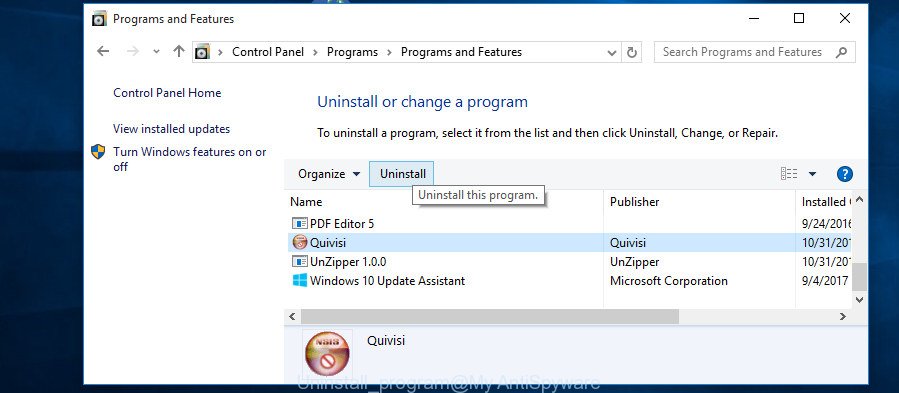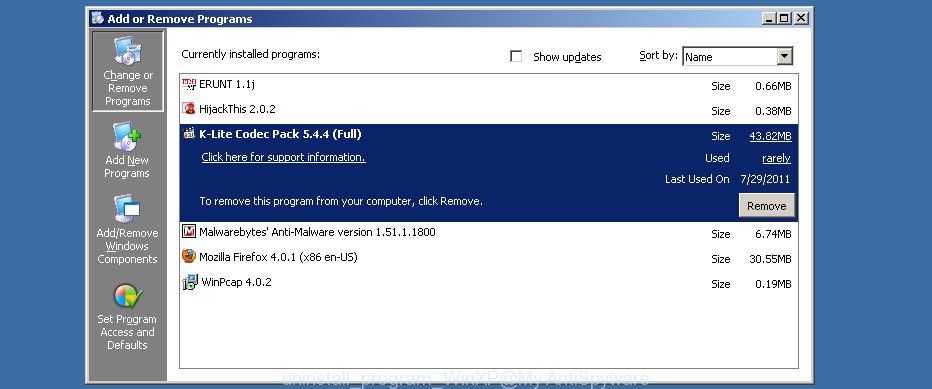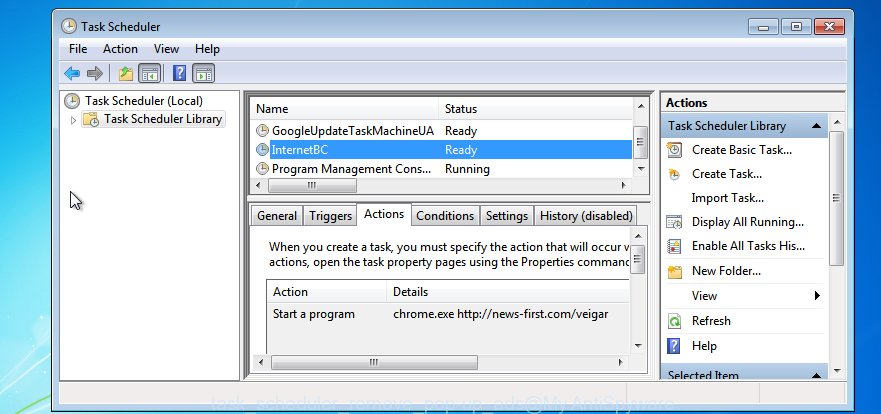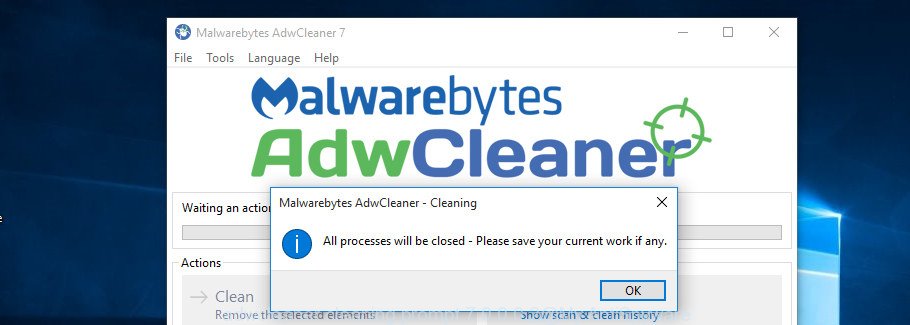Every time, when you surf the Net with your web browser the Adf.ly pop-up ads keeps annoying you? It’s possible that your machine is infected with an ‘ad-supported’ software (also known as adware) that can end up on your computer in various ways. Most often is when you download and install free programs and forget to uncheck the box for the additional applications installation. Do not panic because we’ve got the solution. Here’s a instructions on how to delete undesired Adf.ly pop-up advertisements from the Google Chrome, Firefox, Microsoft Internet Explorer and Edge and other web browsers.

The adware responsible for Adf.ly pop-ups, is the part of the software that is used as an online promotional utility. It’s made with the sole purpose to open dozens of pop up advertisements, and thus to promote the goods and services in an open web-browser window. Moreover, the adware can substitute the legitimate advertising banners on misleading or even banners that can offer to visit malicious web-sites. The reason is simple, many advertisers agree on any ways to attract users to their web pages, so the authors of adware, often forcing users to click on an advertising link. For each click on a link, the developers of the adware receive income.
Most often, the adware infects the most common web browsers such as the Google Chrome, Firefox, Microsoft Internet Explorer and Edge. But such the harmful software as well may infect another web-browsers by changing its shortcuts (adding an argument such as ‘http://site.address’ into Target field of a internet browser’s shortcut). So every time you run the internet browser, it will redirect to the intrusive Adf.ly web-site. Even if you setup a new startpage, an annoying site will be the first thing you see when you run the Chrome, IE, Mozilla Firefox and MS Edge.
So, obviously, you need to delete the adware as soon as possible. Use the free tutorial below. This guide will allow you clean your computer of ad supported software and thereby get rid of the Adf.ly undesired advertisements.
Remove Adf.ly redirect (removal steps)
There are several steps to deleting the ‘ad supported’ software which cause intrusive Adf.ly pop up advertisements to appear, because it installs itself so deeply into Windows. You need to delete all suspicious and unknown applications, then get rid of harmful extensions from the Chrome, Mozilla Firefox, Internet Explorer and MS Edge and other browsers you’ve installed. Finally, you need to reset your web browser settings to get rid of any changes the adware has made, and then scan your personal computer with Zemana Anti-Malware (ZAM), MalwareBytes Anti Malware (MBAM) or AdwCleaner to ensure the adware is fully removed. It will take a while.
To remove Adf.ly, complete the steps below:
- Get rid of Adf.ly pop-up advertisements without any tools
- Uninstall Adf.ly related programs through the Control Panel of your PC
- Remove unwanted Scheduled Tasks
- Delete Adf.ly from FF by resetting web browser settings
- Delete Adf.ly popups from Microsoft Internet Explorer
- Remove Adf.ly pop ups from Google Chrome
- Fix internet browser shortcuts, modified by ad supported software
- Remove Adf.ly pop-up advertisements with free programs
- Stop Adf.ly redirect and other undesired web sites
- How to Adf.ly pop-up ads get installed onto machine
- To sum up
Get rid of Adf.ly pop-up advertisements without any tools
The instructions will help you get rid of Adf.ly pop up advertisements. These Adf.ly removal steps work for the Chrome, FF, Microsoft Edge and Internet Explorer, as well as every version of Microsoft Windows operating system.
Uninstall Adf.ly related programs through the Control Panel of your PC
Some potentially unwanted programs, browser hijacking software and ad-supported software can be deleted by uninstalling the free software they came with. If this way does not succeed, then looking them up in the list of installed software in Windows Control Panel. Use the “Uninstall” command in order to delete them.
Press CTRL, ALT, DEL keys together to open the MS Windows Task Manager.

Click on the “Processes” tab, look for something like Adf.ly then right-click it and select “End Task” or “End Process” option.
Next, uninstall any unknown and suspicious software from your Control panel.
Windows 10, 8.1, 8
Now, press the Windows button, type “Control panel” in search and press Enter. Choose “Programs and Features”, then “Uninstall a program”.

Select the program which has the name similar to “Adf.ly”, uninstall it.
Windows Vista, 7
Close all open internet browsers including the Mozilla Firefox, Google Chrome, Internet Explorer and MS Edge. From the “Start” menu in Microsoft Windows, select “Control Panel”. Under the “Programs” icon, choose “Uninstall a program”.

Select the applications with the names such as Adf.ly, then press “Uninstall/Change” button to uninstall this undesired program from your personal computer.
Windows XP
Click the “Start” button, select “Control Panel” option. Click on “Add/Remove Programs”.

Select the application called like Adf.ly, the press “Change/Remove” button. Follow the prompts.
Remove unwanted Scheduled Tasks
Once installed, the adware can add a task in to the Windows Task Scheduler Library. Due to this, every time when you run your computer, it will show Adf.ly annoying web page. So, you need to check the Task Scheduler Library and get rid of all harmful tasks which have been created by malicious application.
Press Windows and R keys on the keyboard at the same time. This displays a dialog box that called Run. In the text field, type “taskschd.msc” (without the quotes) and press OK. Task Scheduler window opens. In the left-hand side, click “Task Scheduler Library”, like below.

Task scheduler
In the middle part you will see a list of installed tasks. Please choose the first task, its properties will be show just below automatically. Next, click the Actions tab. Pay attention to that it launches on your PC system. Found something like “explorer.exe http://site.address” or “chrome.exe http://site.address”, then remove this malicious task. If you are not sure that executes the task, check it through a search engine. If it is a component of the ‘ad-supported’ programs, then this task also should be removed.
Having defined the task that you want to delete, then click on it with the right mouse button and choose Delete as shown on the screen below.

Delete a task
Repeat this step, if you have found a few tasks that have been created by ‘ad-supported’ program. Once is done, close the Task Scheduler window.
Delete Adf.ly from FF by resetting web browser settings
Resetting your Firefox is first troubleshooting step for any issues with your web-browser application, including the redirect to Adf.ly web page.
First, open the Firefox and click ![]() button. It will display the drop-down menu on the right-part of the browser. Further, click the Help button (
button. It will display the drop-down menu on the right-part of the browser. Further, click the Help button (![]() ) as shown on the screen below
) as shown on the screen below
.

In the Help menu, select the “Troubleshooting Information” option. Another way to open the “Troubleshooting Information” screen – type “about:support” in the web-browser adress bar and press Enter. It will display the “Troubleshooting Information” page as shown on the image below. In the upper-right corner of this screen, press the “Refresh Firefox” button.

It will show the confirmation dialog box. Further, click the “Refresh Firefox” button. The Firefox will begin a task to fix your problems that caused by the adware responsible for redirects to Adf.ly. After, it is finished, click the “Finish” button.
Delete Adf.ly popups from Microsoft Internet Explorer
If you find that Internet Explorer browser settings such as home page, new tab and default search provider having been modified by ad supported software responsible for Adf.ly pop-up ads, then you may return your settings, via the reset web browser procedure.
First, run the Internet Explorer, then click ‘gear’ icon ![]() . It will open the Tools drop-down menu on the right part of the browser, then click the “Internet Options” like below.
. It will open the Tools drop-down menu on the right part of the browser, then click the “Internet Options” like below.

In the “Internet Options” screen, select the “Advanced” tab, then click the “Reset” button. The Internet Explorer will display the “Reset Internet Explorer settings” dialog box. Further, click the “Delete personal settings” check box to select it. Next, click the “Reset” button as displayed on the screen below.

After the procedure is finished, click “Close” button. Close the Internet Explorer and reboot your personal computer for the changes to take effect. This step will help you to restore your internet browser’s homepage, newtab and default search engine to default state.
Remove Adf.ly pop ups from Google Chrome
Reset Chrome settings is a easy way to remove the adware, malicious and adware extensions, as well as to restore the internet browser’s start page, newtab and search provider by default that have been replaced by ad supported software that causes annoying Adf.ly pop-up advertisements.
First start the Chrome. Next, click the button in the form of three horizontal dots (![]() ).
).
It will display the Google Chrome menu. Choose More Tools, then click Extensions. Carefully browse through the list of installed extensions. If the list has the add-on signed with “Installed by enterprise policy” or “Installed by your administrator”, then complete the following guide: Remove Chrome extensions installed by enterprise policy.
Open the Google Chrome menu once again. Further, press the option named “Settings”.

The web browser will display the settings screen. Another solution to display the Google Chrome’s settings – type chrome://settings in the web browser adress bar and press Enter
Scroll down to the bottom of the page and click the “Advanced” link. Now scroll down until the “Reset” section is visible, as shown on the image below and press the “Reset settings to their original defaults” button.

The Chrome will show the confirmation prompt as shown in the following example.

You need to confirm your action, click the “Reset” button. The browser will start the process of cleaning. Once it is finished, the internet browser’s settings including startpage, new tab and search engine by default back to the values that have been when the Google Chrome was first installed on your personal computer.
Fix internet browser shortcuts, modified by ad supported software
Now you need to clean up the internet browser shortcuts. Check that the shortcut referring to the right exe-file of the internet browser, and not on any unknown file.
Right click on the shortcut file of infected web browser as on the image below.

Select the “Properties” option and it’ll display the shortcut file’s properties. Next, press the “Shortcut” tab and then delete the “http://site.address” string from Target field as displayed in the following example.

Then press OK to save changes. Repeat the step for all browsers which are re-directed to the Adf.ly intrusive web page.
Remove Adf.ly pop-up advertisements with free programs
Manual removal is not always as effective as you might think. Often, even the most experienced users can not completely remove adware that causes multiple unwanted pop up ads. So, we suggest to check your system for any remaining harmful components with free adware removal applications below.
Remove Adf.ly popups with Zemana Anti-malware
We advise using the Zemana Anti-malware. You may download and install Zemana Anti-malware to search for and get rid of Adf.ly redirect from the Firefox, Google Chrome, Microsoft Internet Explorer and MS Edge browsers. When installed and updated, the malicious software remover will automatically check and detect all threats present on your PC.
Please go to the link below to download Zemana Anti-Malware (ZAM). Save it to your Desktop so that you can access the file easily.
165054 downloads
Author: Zemana Ltd
Category: Security tools
Update: July 16, 2019
Once the download is complete, start it and follow the prompts. Once installed, the Zemana Free will try to update itself and when this task is done, click the “Scan” button to perform a system scan for the adware responsible for redirects to Adf.ly.

A system scan may take anywhere from 5 to 30 minutes, depending on your system. During the scan Zemana will detect all threats present on your computer. In order to get rid of all threats, simply click “Next” button.

The Zemana Free will remove adware that created to redirect your internet browser to various ad web-pages such as Adf.ly.
Remove Adf.ly pop-up ads with Malwarebytes
Manual Adf.ly pop up advertisements removal requires some computer skills. Some files and registry entries that created by the ad supported software may be not completely removed. We recommend that use the Malwarebytes Free that are completely clean your computer of ad supported software. Moreover, the free application will help you to get rid of malware, potentially unwanted programs, hijackers and toolbars that your PC system can be infected too.

- Visit the page linked below to download the latest version of MalwareBytes Anti-Malware for MS Windows. Save it directly to your MS Windows Desktop.
Malwarebytes Anti-malware
327280 downloads
Author: Malwarebytes
Category: Security tools
Update: April 15, 2020
- At the download page, click on the Download button. Your web browser will display the “Save as” prompt. Please save it onto your Windows desktop.
- After the downloading process is finished, please close all programs and open windows on your PC system. Double-click on the icon that’s called mb3-setup.
- This will open the “Setup wizard” of MalwareBytes Free onto your computer. Follow the prompts and don’t make any changes to default settings.
- When the Setup wizard has finished installing, the MalwareBytes Anti Malware will start and display the main window.
- Further, click the “Scan Now” button to perform a system scan for the ad-supported software responsible for redirecting your web-browser to Adf.ly page. This procedure can take some time, so please be patient. While the MalwareBytes Free is scanning, you can see number of objects it has identified either as being malware.
- After the scan is finished, MalwareBytes Free will show a list of all items found by the scan.
- Review the scan results and then click the “Quarantine Selected” button. When finished, you may be prompted to restart the machine.
- Close the Anti Malware and continue with the next step.
Video instruction, which reveals in detail the steps above.
Double-check for potentially unwanted applications with AdwCleaner
If MalwareBytes anti malware or Zemana Anti Malware (ZAM) cannot remove this adware, then we suggests to use the AdwCleaner. AdwCleaner is a free removal tool for hijacker infections, potentially unwanted software, toolbars and ad-supported software responsible for redirecting your web browser to Adf.ly web-site.
Visit the page linked below to download the latest version of AdwCleaner for Windows. Save it on your Microsoft Windows desktop or in any other place.
225634 downloads
Version: 8.4.1
Author: Xplode, MalwareBytes
Category: Security tools
Update: October 5, 2024
Once the download is complete, open the directory in which you saved it. You will see an icon like below.
![]()
Double click the AdwCleaner desktop icon. Once the utility is started, you will see a screen as shown in the figure below.

Further, click “Scan” button for scanning your machine for the adware which created to redirect your browser to various ad web-pages like Adf.ly. A system scan can take anywhere from 5 to 30 minutes, depending on your computer. When AdwCleaner has completed scanning your system, AdwCleaner will open a list of all threats found by the scan as shown below.

Review the scan results and then click “Clean” button. It will display a dialog box as shown below.

You need to press “OK”. When disinfection is done, the AdwCleaner may ask you to reboot your PC system. When your machine is started, you will see an AdwCleaner log.
These steps are shown in detail in the following video guide.
Stop Adf.ly redirect and other undesired web sites
By installing an adblocker program such as AdGuard, you’re able to block Adf.ly, autoplaying video ads and remove a ton of distracting and intrusive ads on web sites.
Download AdGuard program on your PC from the following link.
26903 downloads
Version: 6.4
Author: © Adguard
Category: Security tools
Update: November 15, 2018
Once downloading is done, run the downloaded file. You will see the “Setup Wizard” screen as shown in the following example.

Follow the prompts. When the setup is done, you will see a window as on the image below.

You can press “Skip” to close the installation program and use the default settings, or click “Get Started” button to see an quick tutorial that will help you get to know AdGuard better.
In most cases, the default settings are enough and you do not need to change anything. Each time, when you launch your machine, AdGuard will start automatically and stop pop-up advertisements, web-pages such Adf.ly, as well as other malicious or misleading sites. For an overview of all the features of the program, or to change its settings you can simply double-click on the AdGuard icon, which is located on your desktop.
How to Adf.ly pop-up ads get installed onto machine
The ‘ad supported’ software usually is bundled with another program in the same installer. The risk of this is especially high for the various free applications downloaded from the Net. The authors of the software are hoping that users will run the quick setup type, that is simply to click the Next button, without paying attention to the information on the screen and don’t carefully considering every step of the installation procedure. Thus, the adware can infiltrate your computer without your knowledge. Therefore, it is very important to read all the information that tells the application during installation, including the ‘Terms of Use’ and ‘Software license’. Use only the Manual, Custom or Advanced installation method. This mode will help you to disable all optional and unwanted programs and components.
To sum up
Once you’ve finished the tutorial outlined above, your PC should be clean from ‘ad supported’ software which developed to redirect your web browser to various ad web pages such as Adf.ly and other malware. The Google Chrome, FF, Internet Explorer and Edge will no longer redirect you to various undesired web-sites similar to Adf.ly. Unfortunately, if the step-by-step guide does not help you, then you have caught a new adware, and then the best way – ask for help in our Spyware/Malware removal forum.




















